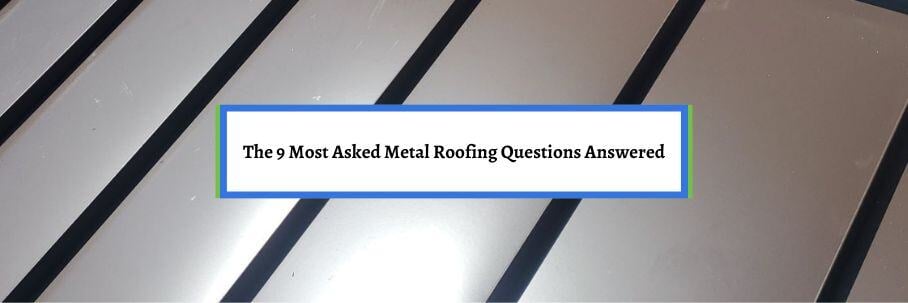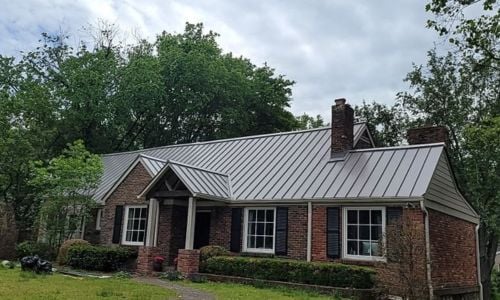The 9 Most Asked Metal Roofing Questions Answered

Are you considering metal roofing for your upcoming roof replacement? Do you have questions you need answered before fully committing to it as a roofing material?
Metal’s popularity in residential roofing has skyrocketed over the last 10 years, but it’s not a good fit for every homeowner. That’s why you need to learn as much as possible to determine if it’s right for you.
For over 30 years, Bill Ragan Roofing has taken pride in laying out the facts so homeowners feel confident in their roofing decisions. Because of this, I want to help you decide if metal roofing is a good option by answering the most commonly asked questions.
By the end of this article, you’ll have the answers to the following metal roofing questions:
- Which metal roof system is recommended for residential roofing?
- What are the best metal options?
- Does metal roofing make noise when it rains?
- How long does a metal roof last?
- Is a metal roof more expensive than an asphalt shingle roof?
- How much does metal roofing cost?
- Does metal roofing require maintenance?
- Are metal roofs energy efficient?
- Can storms damage metal roofing?
1. Which metal roof system is recommended for residential roofing?
There are two types of residential metal roof systems: exposed fastener and standing seam. An exposed fastener metal roof (also called screw down panel) is fastened down with screws that are left exposed.

The fasteners go through the metal panels to attach directly to the roof decking. The problem is that the metal can’t expand and contract, which creates leak opportunities when the pressure eventually causes the screws to back out.

A standing seam metal roof is a series of panels locked together at the seams with clips or seamed mechanically. Because they’re fastened together underneath, the panels can glide freely when expanding and contracting.
That’s why a standing seam metal roof system is recommended for residential roofing projects, especially over heated living spaces.
2. What are the best metal options?
Metal roofing has plenty of metal options based on budget, personal style preferences, and how much life you want to get out of your metal roof. However, some are used more often than others.
The most common types of metal used in residential metal roofing are:
- Steel metal roofing
- Aluminum metal roofing
- Copper metal roofing
- Stainless steel metal roofing
- Zinc metal roofing
While all are great options with pros and cons, the two most popular are prefinished steel and aluminum. This is mainly due to affordability, but premium metals (copper, stainless steel, and zinc) may also not be readily available in certain areas.
3. Does metal roofing make noise when it rains?
You will always hear rain hitting a metal roof inside your home, but there are ways to dull it. Solid decking helps because the wooden boards absorb some of the noise.
You can take it further by adding wood fiber insulation boards between the decking and metal panels. This creates an extra layer to absorb sound, but it even won’t completely block out a heavy downpour.
Everyone’s tolerance is different, so just consider the noise factor when deciding if metal roofing is right for you.
4. How long does a metal roof last?
A new roof increases your home’s value, but the main return on investment is how long it'll last. With that in mind, a metal roof’s lifespan depends on the metal roof system.
Properly installed with no maintenance, a steel screw down metal roof should last 20 years. With maintenance, it can last up to 30 years.
On the other hand, a steel standing seam metal roof with a Kynar 500 painted finish should last 30 years and can even get up to 50. While this is a very long lifespan, premium metals like copper, stainless steel, and zinc will last well over 50 years.
5. Is a metal roof more expensive than an asphalt shingle roof?
A metal roof is almost always more expensive than shingles. However, it heavily depends on the metal type and metal roof system.
An aluminum or steel exposed fastener metal roof will be pretty comparable or a little more expensive than a standard architectural shingle roof. However, a standing seam metal roof will cost double or triple more than an asphalt roof (depending on the shingle type).
Not only do the metal panels themselves cost more than asphalt shingles, but standing seam installation is a different expertise that requires more skill and labor. Just keep in mind the price gap grows even more if you choose one of the premium metals.
6. How much does metal roofing cost?
According to the 2024 Cost vs. Value Report, the average cost of a new metal roof is $49,928. This general average is for a prefinished steel standing seam metal roof on a 3,000-square-foot roof.
Roofs come in all shapes and sizes, so it’s hard to use this average as a guideline. However, I can break it down to a per-square-foot cost based on the type of metal roof system.
For labor and materials, a steel exposed fastener metal roof costs around $4.50 to $6.50 per square foot. However, there will also be maintenance fees to replace the screws throughout its life.
On the other hand, a new steel standing seam metal roof costs around $16.00 per square foot. Aluminum can be cheaper or cost a little more based on availability, but premium metals get much more expensive.
7. Does metal roofing require maintenance?
Every roof needs maintenance, and metal roofing is no different. But just like most things we’ve covered, the amount is different for each metal roof system.
A standing seam roof only needs periodic maintenance around the penetrations (vent pipes, gas pipes, etc.) and to clear it of sitting debris. You can also clean the panels when they get dirty as the years pass, but this is up to you.
On the other hand, a screw down metal roof needs yearly maintenance to check the fasteners. The pressure caused by a lack of expansion and contraction wallows out the washer holes holding the screws, which leads to having to replace them every 5-10 years.
-2.png?width=612&height=501&name=ScrewDownMetalScrewsWallowed%20(2)-2.png)
Failing to replace the screws during maintenance will cause leaks, and strong storms can lift the panels. With all this in mind, I always recommend a yearly maintenance inspection for metal roofing and any roofing material.
8. Are metal roofs energy efficient?
Metal roofs are great for energy efficiency, mainly for their natural reflective properties. They also release heat quickly (emissivity), which helps them cool down more efficiently in hotter areas when the sun goes down.
Just know that darker colors absorb more heat, and each metal type has different reflective properties. That’s why steel and aluminum panels come with some kind of “cool” coating or painted finish.
These coatings and paints meet Energy Star standards to enhance reflectivity and emissivity, which can reduce air conditioning usage by up to 25% in hotter climates.
9. Can storms damage metal roofing?
While not as prone as other roofing materials, metal roofing can get damaged by storms. Unless wind can get under the metal panels, you won’t have to worry about wind damage.
While wind doesn’t usually cause direct damage, fallen trees or limbs can significantly damage metal panels. On the other hand, large hail can damage metal panels and the protective painted finish (if applied).
This is especially true for softer metals, like copper and aluminum. However, it would have to be a significant hail storm or prolonged exposure to hail to really notice it.
Is metal roofing the right material for your roof replacement?
After reading this article, you now have the answers to the most frequently asked metal roofing questions. At this point, you should have a pretty good idea of whether metal is the right roofing material for your roof replacement.
But can you be fully confident you’re making the right decision if you don’t know the other options available? After all, there’s a wide variety of roofing materials, and each one comes with its pros and cons.
So, before picking up the phone to call a roofer, let’s take a look at the top residential roofing materials to ensure you make the best choice.
Check out The Top 8 Roofing Materials (How to Choose the Right One) to learn the cost, lifespan, and warranties, plus the pros and cons of the most popular materials.


